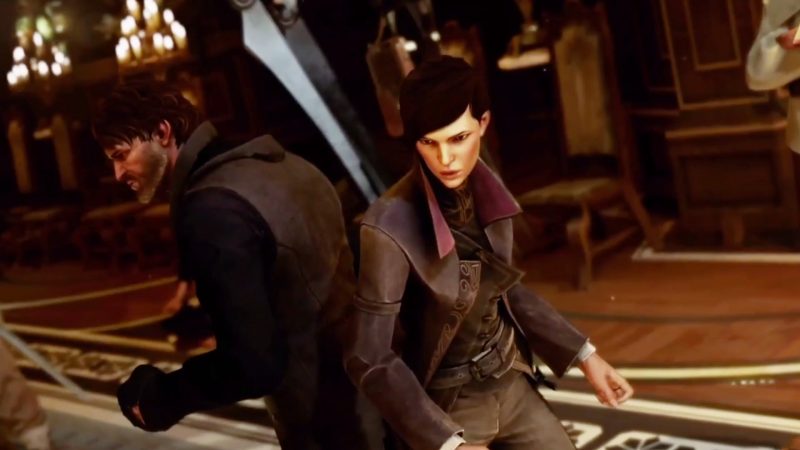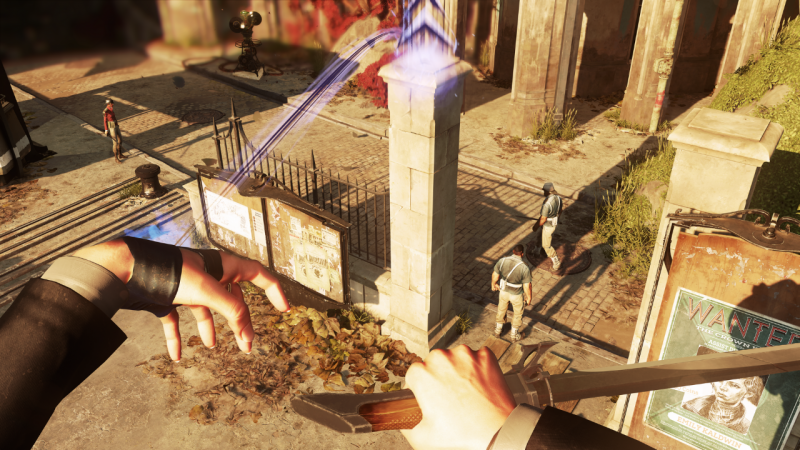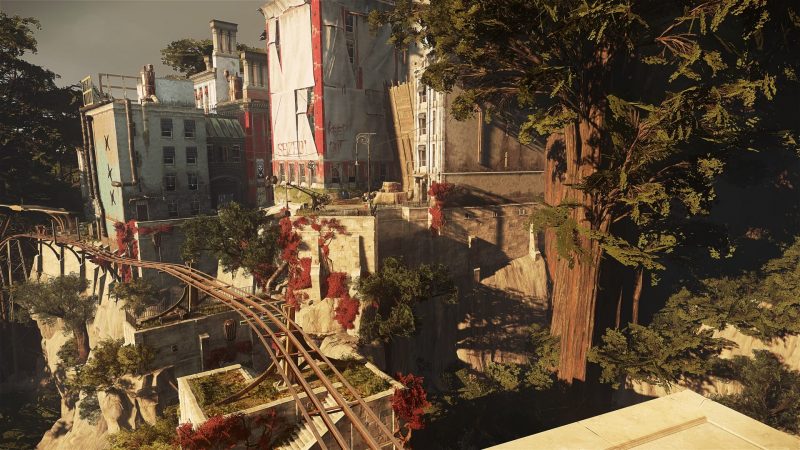Dishonored 2 Review
"Dishonored is Back, Bringing With it Gleeful Mayhem and Creative Stealth"
When
Dishonored came out in 2012, many players realized isn’t wasn’t a game as much as it was an engine for chaos and experimentation. While it was a fine enough story, the real joy in playing it came out in experimenting with its strange, wonderful powers and exploring it's creative, well-realized world.
Dishonored 2 is here, and it’s an experience tailor-made for fans of the first game. It has all the strengths of creative gameplay and fun world interactions, but it’s also let down by a weak story and technical issues.
Much like the first game,
Dishonored 2 tells the story of royal-bodyguard-turned-assassin Corvo Attano and Emily Kaldwin, the former Empress of Dunwall. Emily was just a little girl in the original game. In the fifteen years between that and
Dishonored 2, she has led the port city of Dunwall to prosperity. The setup for the game is simple. Emily’s enemies are being brutally murdered, and the public begins to suspect her and Corvo are responsible. During a ceremony in remembrance of Emily’s mother and the former empress, the Duke of Serkonos, a city in the south of the empire, arrives. The Duke’s men attack and the player is forced to flee Dunwall after choosing to play as Emily or Corvo. From there, the player travels to Serkonos to embark on a trail to prove your innocence, reclaim the throne, and get revenge.
[caption id="attachment_90679" align="aligncenter" width="800"]

Protagonists Corvo Attano and Emily Kaldwin[/caption]
It’s a fairly similar setup to the first game (being framed for murder, having to prove innocence while being hunted by authorities, etc.) but it’s a solid enough concept that it works well. The option of two different playable characters prevents the story from seeming too stale or repeated from the original.
The choice between characters is primarily a gameplay one, not a narrative one. The story plays out in a similar way regardless of who you choose, with the bulk of story differences being determined by how you play the game. Like the first
Dishonored, you can play “High Chaos” – slaughtering indiscriminately and disregarding the well-being of civilians. There's also “Low Chaos” – being sneaky and non-lethal wherever possible.
For players interested in the “Low Chaos” route, developer Arkane Studios has added a lot to love. One of the first game’s major criticisms was that playing non-lethally was fairly boring. Most of the cool powers and weapons were reserved for killing. Players would end up just using sleep darts and choking guards unconscious for most of the playthrough.
Dishonored 2 introduces a wider variety of non-lethal combat moves as well as more powers focused on stealth or distraction.
The roster of powers is one of the most compelling parts of
Dishonored 2’s stealth system. Fan favorites like “Devouring Swarm” (summoning a swarm of rats) and “Bend Time” (slowing down time for quick escapes or attacks) are back. There's also some new and exciting abilities to mess around with that I won’t spoil here. Emily and Corvo both have their own sets of abilities, meaning that the game is ripe for replay possibilities.
[caption id="attachment_90674" align="alignnone" width="800"]

Emily using her new "Far Reach" power.[/caption]
The city of Karnaca is a vibrant and thriving city full of things to do. Where
Dishonored’s Dunwall often felt empty and decaying, Karnaca is full of people going about their daily lives. Every mission isn’t purely a stealth arena. You’ll traverse markets, fisheries, and streets full of civilians offering quips, advice, and comments on the player’s deeds. Some will even offer optional side missions to do while completing the main story.
Each of the story missions relies on a unique “theme” or mechanic. It means each new level presents a new set of interesting challenges. One level involves periodic dust storms that obscure both the player and guards’ vision. Another involves time distortion mechanics that allow the player to shift back and forth between two points in time. While some of the levels are more interesting and creative than others, it’s a good opportunity for the player to learn new ways to use their abilities and experiment.
[caption id="attachment_90675" align="alignnone" width="800"]

Karnaca, the "Jewel of the South at the Edge of the World"[/caption]
This experimentation is, like in the first game,
Dishonored 2’s strongest point. The plethora of weapons and powers it gives you are practically begging to be experimented with. Some of the most fun to be had is in seeing how the different powers can interact with each other and the environment to create a dazzling display of chaos and death.
One area that
Dishonored 2 failed to improve on, however, is the visuals. They are only on par with the first game. The original game came out in 2012, and in the four years since the graphics for the game haven’t improved much, nor have the issues. That means that you’ll often find muddy textures, stiff and weirdly animated NPCs, and occasional issues with pop-in. The art style is creative and distinct. However this isn’t the game to go to if you’re looking for cutting-edge graphics.
Dishonored 2 is, at its core, just more
Dishonored. The story is similar, the gameplay style is the game, and the visuals are just about equal. That’s in no way a condemnation of the game, though. If you enjoyed the first game, everything you loved is back and better than ever. There's more choices and depth than before. It’s more of the same, and that’s a great thing. It’s a refinement of a fantastic game. While it doesn’t really do anything new, it does what it does incredibly well.
Pros
- Excellent Stealth Gameplay
- Fun New Powers
- New Opportunities for Replay
- An Interesting and Living World
Cons
- More of the Same
- Weak Story
- Technical Issues
 Protagonists Corvo Attano and Emily Kaldwin[/caption]
It’s a fairly similar setup to the first game (being framed for murder, having to prove innocence while being hunted by authorities, etc.) but it’s a solid enough concept that it works well. The option of two different playable characters prevents the story from seeming too stale or repeated from the original.
The choice between characters is primarily a gameplay one, not a narrative one. The story plays out in a similar way regardless of who you choose, with the bulk of story differences being determined by how you play the game. Like the first Dishonored, you can play “High Chaos” – slaughtering indiscriminately and disregarding the well-being of civilians. There's also “Low Chaos” – being sneaky and non-lethal wherever possible.
For players interested in the “Low Chaos” route, developer Arkane Studios has added a lot to love. One of the first game’s major criticisms was that playing non-lethally was fairly boring. Most of the cool powers and weapons were reserved for killing. Players would end up just using sleep darts and choking guards unconscious for most of the playthrough. Dishonored 2 introduces a wider variety of non-lethal combat moves as well as more powers focused on stealth or distraction.
The roster of powers is one of the most compelling parts of Dishonored 2’s stealth system. Fan favorites like “Devouring Swarm” (summoning a swarm of rats) and “Bend Time” (slowing down time for quick escapes or attacks) are back. There's also some new and exciting abilities to mess around with that I won’t spoil here. Emily and Corvo both have their own sets of abilities, meaning that the game is ripe for replay possibilities.
[caption id="attachment_90674" align="alignnone" width="800"]
Protagonists Corvo Attano and Emily Kaldwin[/caption]
It’s a fairly similar setup to the first game (being framed for murder, having to prove innocence while being hunted by authorities, etc.) but it’s a solid enough concept that it works well. The option of two different playable characters prevents the story from seeming too stale or repeated from the original.
The choice between characters is primarily a gameplay one, not a narrative one. The story plays out in a similar way regardless of who you choose, with the bulk of story differences being determined by how you play the game. Like the first Dishonored, you can play “High Chaos” – slaughtering indiscriminately and disregarding the well-being of civilians. There's also “Low Chaos” – being sneaky and non-lethal wherever possible.
For players interested in the “Low Chaos” route, developer Arkane Studios has added a lot to love. One of the first game’s major criticisms was that playing non-lethally was fairly boring. Most of the cool powers and weapons were reserved for killing. Players would end up just using sleep darts and choking guards unconscious for most of the playthrough. Dishonored 2 introduces a wider variety of non-lethal combat moves as well as more powers focused on stealth or distraction.
The roster of powers is one of the most compelling parts of Dishonored 2’s stealth system. Fan favorites like “Devouring Swarm” (summoning a swarm of rats) and “Bend Time” (slowing down time for quick escapes or attacks) are back. There's also some new and exciting abilities to mess around with that I won’t spoil here. Emily and Corvo both have their own sets of abilities, meaning that the game is ripe for replay possibilities.
[caption id="attachment_90674" align="alignnone" width="800"] Emily using her new "Far Reach" power.[/caption]
The city of Karnaca is a vibrant and thriving city full of things to do. Where Dishonored’s Dunwall often felt empty and decaying, Karnaca is full of people going about their daily lives. Every mission isn’t purely a stealth arena. You’ll traverse markets, fisheries, and streets full of civilians offering quips, advice, and comments on the player’s deeds. Some will even offer optional side missions to do while completing the main story.
Each of the story missions relies on a unique “theme” or mechanic. It means each new level presents a new set of interesting challenges. One level involves periodic dust storms that obscure both the player and guards’ vision. Another involves time distortion mechanics that allow the player to shift back and forth between two points in time. While some of the levels are more interesting and creative than others, it’s a good opportunity for the player to learn new ways to use their abilities and experiment.
[caption id="attachment_90675" align="alignnone" width="800"]
Emily using her new "Far Reach" power.[/caption]
The city of Karnaca is a vibrant and thriving city full of things to do. Where Dishonored’s Dunwall often felt empty and decaying, Karnaca is full of people going about their daily lives. Every mission isn’t purely a stealth arena. You’ll traverse markets, fisheries, and streets full of civilians offering quips, advice, and comments on the player’s deeds. Some will even offer optional side missions to do while completing the main story.
Each of the story missions relies on a unique “theme” or mechanic. It means each new level presents a new set of interesting challenges. One level involves periodic dust storms that obscure both the player and guards’ vision. Another involves time distortion mechanics that allow the player to shift back and forth between two points in time. While some of the levels are more interesting and creative than others, it’s a good opportunity for the player to learn new ways to use their abilities and experiment.
[caption id="attachment_90675" align="alignnone" width="800"] Karnaca, the "Jewel of the South at the Edge of the World"[/caption]
This experimentation is, like in the first game, Dishonored 2’s strongest point. The plethora of weapons and powers it gives you are practically begging to be experimented with. Some of the most fun to be had is in seeing how the different powers can interact with each other and the environment to create a dazzling display of chaos and death.
One area that Dishonored 2 failed to improve on, however, is the visuals. They are only on par with the first game. The original game came out in 2012, and in the four years since the graphics for the game haven’t improved much, nor have the issues. That means that you’ll often find muddy textures, stiff and weirdly animated NPCs, and occasional issues with pop-in. The art style is creative and distinct. However this isn’t the game to go to if you’re looking for cutting-edge graphics.
Dishonored 2 is, at its core, just more Dishonored. The story is similar, the gameplay style is the game, and the visuals are just about equal. That’s in no way a condemnation of the game, though. If you enjoyed the first game, everything you loved is back and better than ever. There's more choices and depth than before. It’s more of the same, and that’s a great thing. It’s a refinement of a fantastic game. While it doesn’t really do anything new, it does what it does incredibly well.
Karnaca, the "Jewel of the South at the Edge of the World"[/caption]
This experimentation is, like in the first game, Dishonored 2’s strongest point. The plethora of weapons and powers it gives you are practically begging to be experimented with. Some of the most fun to be had is in seeing how the different powers can interact with each other and the environment to create a dazzling display of chaos and death.
One area that Dishonored 2 failed to improve on, however, is the visuals. They are only on par with the first game. The original game came out in 2012, and in the four years since the graphics for the game haven’t improved much, nor have the issues. That means that you’ll often find muddy textures, stiff and weirdly animated NPCs, and occasional issues with pop-in. The art style is creative and distinct. However this isn’t the game to go to if you’re looking for cutting-edge graphics.
Dishonored 2 is, at its core, just more Dishonored. The story is similar, the gameplay style is the game, and the visuals are just about equal. That’s in no way a condemnation of the game, though. If you enjoyed the first game, everything you loved is back and better than ever. There's more choices and depth than before. It’s more of the same, and that’s a great thing. It’s a refinement of a fantastic game. While it doesn’t really do anything new, it does what it does incredibly well.